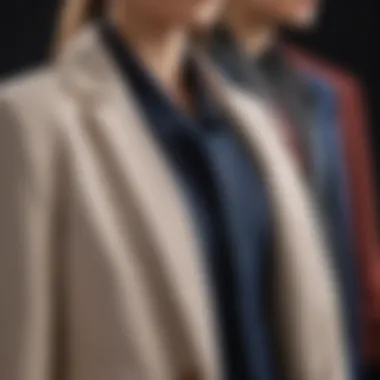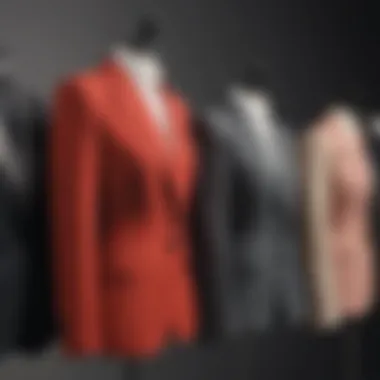Understanding Blazer Sleeve Length for Women's Fit


Intro
In the world of women’s fashion, the fit and style of a blazer can make or break an outfit. One of the key elements influencing this aspect is the blazer sleeve length. The right sleeve length can enhance your overall silhouette, create balance in your proportions, and contribute significantly to both comfort and style.
Women have numerous options when selecting blazers, from tailored pieces for professional settings to more relaxed styles for casual outings. Each of these categories has its own unique expectations for sleeve length, heavily influenced by the current trends and personal preferences. In this guide, we will explore these elements in-depth, ensuring that you're well-equipped to make stylish and comfortable choices.
Fashion Trends
Blazers are no longer relegated to boardrooms or formal events; they have evolved into versatile wardrobe staples seen on runways, in street style, and even on red carpets.
Runway Highlights
Fashion designers are always pushing the envelope, and recent collections have showcased a range of sleeve lengths that catch the eye. Cropped blazers, for example, have made a striking comeback, featuring sleeves that hit just above the wrist. This style not only emphasizes a woman's arms but also pairs well with high-waisted trousers or skirts, creating an elongated look.
On the other end of the spectrum, long and oversized blazers have become popular as well, with sleeves that extend well past the wrist, often styled with chic cuffs or layered over fitted tops for a mixed media look.
Seasonal Must-Haves
As seasons change, so do the blazers that grace our wardrobes. In the colder months, layering is key, and blazers with longer sleeves are essential. They not only keep you warm but also allow for stylish layering underneath.
In spring and summer, lighter fabrics and shorter sleeves are ideal for those warmer days, providing breathability without losing sophistication. Think linen or cotton blends that flutter with ease.
Celebrity-inspired Looks
Celebrities often set trends in attire, and their choice of blazers can offer insights into modern sleeve length preferences. Consider the looks from icons like Emma Watson, who often opts for tailored yet relaxed fitting blazers with sleeves that gracefully fall just above her wrists. Her choices exemplify how a perfect sleeve length can complement both the outfit and the individual’s frame.
When looking for inspiration, turn to platforms like Reddit or Instagram to see how fashion influencers are styling their blazers, particularly in regard to sleeve lengths.
"The sleeve length of a blazer can transform the entire silhouette. It’s not just about the fabric or cut, but how it frames the arms and shoulders." – Fashion Designer
In summary, understanding blazer sleeve lengths and their influence is fundamental for stylish expression. This article will delve deeper into how you can choose the perfect fit and style for your blazers, ensuring your choices align with current trends and remain timeless.
The Importance of Sleeve Length in Women’s Blazers
When it comes to women’s blazers, sleeve length plays a crucial role that extends beyond mere aesthetics. It's the thread that weaves together functionality, comfort, and style. Not only does the right sleeve length enhance the overall appearance, but it also has the power to complement or disrupt the natural body proportions. A well-fitted blazer can be a cornerstone of a sophisticated wardrobe, making understanding sleeve length a necessary piece of the puzzle.
Functional vs. Aesthetic Considerations
The sleeve length of a blazer isn’t just a matter of how it looks; it’s about how well it serves the wearer’s needs. Functionality is paramount—long sleeves can keep one warm during the chillier months, while shorter lengths may offer more freedom of movement in a busy, professional setting. Here are a few functional considerations:
- Comfort: A sleeve that is too long can hinder movement, while one that is too short may make the wearer uncomfortable or feel exposed.
- Versatility: Adjustable sleeve lengths can make a blazer suitable for a variety of occasions, from formal meetings to casual outings.
- Weather: Depending on the climate, appropriate sleeve length can impact comfort levels significantly.
On the aesthetic side, the right sleeve length can help to elongate or define the arms, framing the wearer’s face or body shape favorably. Consider these aesthetic factors:
- Proportions: The right length can enhance a balanced silhouette.
- Style Trends: Current fashion trends can influence what is considered flattering; knowing the right sleeve length can keep an outfit modern.
- Layering Potential: How a blazer looks when layered over other pieces—like tops, blouses, or shirts—can transform an entire outfit.
Impact on Overall Silhouette
A blazer is often seen as an elongating piece, but the effect can be drastically altered by sleeve length. A too-short sleeve can make a blazer appear boxy or awkward, while a longer sleeve can create a visually appealing line from the shoulders down to the hem.
- Elongation Effects: A longer sleeve tends to give the illusion of longer arms, which can ultimately enhance the wearer’s height. Conversely, a cropped sleeve can draw attention to the waist.
- Balance: Sleeve length affects how body proportions are perceived. For instance, if one has a petite frame, three-quarter sleeves can provide a slenderizing effect without overwhelming one’s stature.
- Style Statements: The length can signal different vibes—short sleeves can imply a more casual, modern look, while full-length sleeves may project professionalism and formality.
"A blazer with the right sleeve length serves as both a versatile wardrobe staple and a canvas for personal expression."
In summary, understanding the importance of sleeve length in women’s blazers allows for better style choices. It ensures that one not only looks fashionable but also feels comfortable and confident, crafting an impression that aligns with personal identity.
Standard Blazer Sleeve Lengths Explained
When it comes to the modern woman’s wardrobe, the sleeve length of blazers is a topic that deserves serious consideration. With each blazer carrying its own set of measurements, understanding these can profoundly influence not just style, but comfort as well. The appropriateness of sleeve length goes beyond personal choice; it has potential ramifications for how one presents oneself in various social situations, be it formal, casual, or professional.
Getting sleeve length right is about making a statement while ensuring a fit that feels like second skin. It’s not just about aesthetics; it speaks volumes about attention to detail, professionalism, and personal style.
Average Measurements for Various Sizes
In the realm of fashion, sleeve lengths can be somewhat tricky, resembling a puzzle that needs to be pieced together. Commonly, blazers for women come with standard sleeve lengths that vary according to sizes such as small, medium, large, and so on.
- Small: On average, the sleeve length is approximately 28 inches, aligning well with typical petite figures.
- Medium: This size generally averages around 29 inches, providing a balanced fit for women of average stature.
- Large: Sleeves in this category often extend to about 30 inches, catering to those with a bit more length in their arms.
- Extra Large: Typically, this can stretch to around 31 inches or more, accommodating longer arm lengths.


The measurements indicated are general guidelines; specific brands might deviate slightly. Therefore, trying on the blazer or checking individual sizing charts is advisable for the most accurate fit.
Considerations for Petite and Tall Frames
The world is beautifully diverse, and women come in all shapes and sizes. Thus, understanding how sleeve lengths work for petite and tall frames is crucial.
Petite women may find blazers with shorter sleeve lengths more flattering. A sleeve length around 26 to 27 inches offers a balanced look, emphasizing proportions without overwhelming the frame. Conversely, women with tall frames should seek out blazers whose lengths span the range of 30 to 33 inches. This helps maintain a harmonious silhouette and avoid the awkwardness of looking like the blazer is too small.
Some key points for consideration:
- Tailoring: Often, petite women might benefit from opting for tailored options that can give a polished appearance without excessive bulk.
- Cuffs: Tall women can sometimes mix and match with longer blazers. Opting for styles that allow for cuffing can provide a chic layered look, making it easier to manage longer sleeves.
Choosing the Right Sleeve Length: Key Factors
Selecting the perfect sleeve length for a women’s blazer is far more than just a style decision; it’s a matter of discovering the sweet spot where fit meets fashion. Getting this aspect right can elevate not just the blazer's appearance but also how it translates into one’s overall silhouette and comfort level. Below, we delve into two key factors that play pivotal roles in making the right choice: body proportions and personal style.
Body Proportions and Sleeve Length
Understanding one’s body proportions is crucial in determining the ideal sleeve length for a blazer. Different body shapes often call for different sleeve lengths to maintain balance and visual harmony. For instance, someone with a slender frame might find that 3/4 sleeves create an elongated look, while a more curvy figure could benefit from full-length sleeves that offer better coverage and support.
When considering body proportions, it’s also important to recognize arm length and shoulder width. For someone with longer arms, opting for jackets with slightly longer sleeves can prevent the uncomfortable appearance of undersized proportions. Conversely, those with shorter arms may feel more comfortable in cropped or bell-sleeved designs, which can create an illusion of longer limbs.
"A well-fitted blazer can be the difference between looking polished or looking like you just rolled out of bed."
- Measurement Tip: While trying on blazers, a good rule of thumb is to ensure that the sleeve ends around the wrist bone. This typically strikes the right balance.
In addition to the measurements, fabric characteristics also matter. Fabrics with a bit of stretch can provide the necessary wiggle room, helping the blazer fit better around varying body shapes. This attention to detail can be the key to staying comfortable without sacrificing style.
Personal Style and Preferred Fit
Another aspect to consider when determining the right sleeve length is individual style and preference. Does one lean towards a more tailored approach, or is relaxed elegance more appealing? Personal style can profoundly influence how one perceives sleeve length.
For those who appreciate a more tailored look, traditional full-length sleeves often convey professionalism and refinement. They can also be stylishly fitted to enhance an hourglass shape. On the other hand, if a person’s aesthetic is more laid-back, exploring options like modern oversized blazers with slightly cropped sleeves might resonate more.
Moreover, the usage of accessories can play a significant role in how a sleeve length might look and feel. Pairing a blazer with a long statement necklace draping to the torso can beautifully contrast with shorter sleeves, creating balanced visual lines. Similarly, rolled-up sleeves also hint at a more casual vibe without losing sophistication.
Diving deeper into personal preference involves considering how the blazer will be worn in terms of occasions. For formal environments, full-length sleeves often maintain a polished look, while social or casual events might allow for a playful approach with shorter sleeves.
In essence, a careful blend of understanding body proportions and tuning into personal style can guide one toward making informed choices about blazer sleeve lengths. The right fit not only enhances physical appearance but enhances confidence—a quality that always shines through.
Blazer Styles and Their Sleeve Length Variations
Understanding the different blazer styles is key for those looking to navigate the often tricky waters of women's fashion. Blazers can be more than just a comfortable layer; their styles directly influence sleeve lengths, greatly affecting both aesthetic appeal and functionality. Choosing the right style can frame your silhouette in ways that enhance or detract from your overall look.
Classic Tailored Blazers
Classic tailored blazers are a wardrobe staple, embodying a structured fit that flatters various body types. Typically, these blazers feature longer sleeves that reach just past the wrist, creating an elegant line that often hits at or just above the break of the wrist. This traditional length helps to elongate the arms, lending the wearer a poised and polished effect. Tailoring plays a vital role here; if your sleeves are too long or short, they can shift the whole balance of an outfit.
For instance, when paired with a crisp white shirt and tailored trousers, a classic tailored blazer can transition smoothly from day to evening engagements. Here are a few reasons to opt for this style:
- Versatility: Works well with formal settings and casual outings alike.
- Timelessness: A classic piece never goes out of style, ensuring long-term usability.
- Bewitching Silhouette: Enhances body contours, particularly for those who may have concerns about their upper body appearance.
Modern Oversized Blazers
On the flip side, modern oversized blazers have exploded in popularity, particularly for those leaning into more relaxed aesthetics. These blazers often feature sleeves that are intentionally broader and slightly longer, sometimes even extending down toward the knuckles. This style invites a casual, laid-back vibe that contrasts sharply with its tailored counterpart.
Oversized blazers can be draped over fitted tops or relaxed tees for a chic, effortlessly stylish look. This pairing can serve a multitude of occasions, from casual outings to laid-back office wear. However, special attention must be paid to the way these blazers are layered to avoid drowning the frame. Key aspects include:
- Comfort: Offers freedom of movement, great for long days.
- Layering Potential: Perfect for adding layers without bulk.
- Fashion-Forward: Appeals to trendsetters looking for a statement piece.
Chic Cropped Blazers
Chic cropped blazers represent a more avant-garde take on traditional blazers. Their sleeves often finish above the wrist, putting a unique spin on length, which creates an air of attitude. These cropped options work wonders when styled with high-waisted pants or dresses, accentuating the waist and creating an enviable silhouette.
Incorporating a cropped blazer into your wardrobe can completely transform your style game. They are easily dressed up or down depending on the occasion, lending a youthful touch to classic outfits. The benefits of these blazers are numerous:
- Edgy Appeal: Instantly adds a funky, modern twist to any outfit.
- Enhanced Proportions: Great for showcasing waistlines, making it perfect for layering over dresses.
- Unique Versatility: Flirt with various looks from bohemian to professional by changing the base attire.


In essence, the choice of blazer style and sleeve length can significantly transform your appearance and the message your outfit communicates to the world.
Navigating blazer styles and their corresponding sleeve lengths can ultimately help you fine-tune your wardrobe, emphasizing your sense of individuality while ensuring practicality.
Achieving the Perfect Fit
When it comes to selecting a blazer, achieving the perfect fit is non-negotiable. It can make or break the overall appearance of your outfit. Unlike jeans, which might have a bit of leeway in size, blazers are often less forgiving. Therefore, understanding how sleeve length interacts with the body’s proportions plays a pivotal role in enhancing both style and comfort.
A well-fitting blazer does more than keep you looking sharp; it boosts your confidence. In a world where first impressions matter, feeling good in your clothes can have significant effects on both personal and professional interactions. While designers might have standardized patterns, no two bodies are the same. This means considering how a blazer hugs your shoulders and how the sleeves reach your wrists is crucial.
There's also an element of function at play. A blazer that fits impeccably allows for ease of movement. Whether you're reaching for a coffee mug or typing furiously at your desk, sleeve length needs to accommodate your lifestyle without pinching or constraining.
"Fit is not just about style; it’s about feeling great in what you wear every day!"
Tailoring and Alterations
Most women’s blazers come out of the store at a one-size-fits-all situation, which can be far from ideal. The key to a tailor-made feel is recognizing that not every blazer fits perfectly right off the rack. With a good tailor, minor tweaks can elevate a blazer from average to exceptional. Common adjustments include shortening or lengthening sleeves, taking in the waist, or even altering the shoulders for more comfort.
When it comes to sleeves specifically, an experienced tailor knows the nuances of how a sleeve’s form affects the overall look. For instance, sometimes a longer sleeve may seem fashionable, but if it covers your hands, it’s not practical. Choosing a skilled tailor can save you headaches down the line. Taking the time and resources to invest in alterations will bring that blazer to life in a way that feels personal.
Materials and Their Stretch Characteristics
Materials play a critical role in how a blazer drapes on your body. Not all fabrics behave the same way when it comes to sleeve lengths. For example, a cotton-blend fabric tends to maintain its shape better than a silk one, which may drape more loosely. Each material offers unique stretch characteristics which can either enhance or detract from your desired fit.
Fabrics with a bit of elastane or spandex can offer the flexibility required for comfort, especially in the sleeves. If you love a snug fit in the arms for a tailored appearance, consider blazers that include these materials. Additionally, understanding the material's weight is important; heavier fabrics lend more structure, whereas lighter fabrics can be more forgiving.
Selecting the right fabric according to the climate will also affect usability. Soft cotton may be more suitable for warmer months, while wool blends can provide warmth during winter. Knowing how these materials interact with your body will play a vital part in achieving the perfect fit for any blazer you choose.
Cultural Influences on Sleeve Length Trends
The length of blazer sleeves is not merely a matter of personal preference; it is deeply entwined with cultural narratives and trends that evolve over time. Understanding these influences sheds light on how women in different societies perceive style, authority, and femininity. In this section, we shall explore the historical context and the global perspectives that communicate the role of sleeve length in today's fashion. This adds depth to our understanding of blazers, moving beyond mere utility to a canvas of cultural expression.
Historical Context and Its Legacy
As we examine historical trends, it’s crucial to consider how the concepts of propriety and professionalism have shifted throughout the decades. In the early 20th century, women's clothing was often constricted by societal norms, emphasizing modesty. Blazers during this time typically featured longer sleeves, reflecting the expectations of women to present themselves in a reserved and conservative manner.
However, the tides turned in the 1960s and 70s, as revolutions in women's rights and fashion liberated the female silhouette. The emergence of tailored blazers with shorter sleeves symbolized a growing independence among women. Today’s struggle against archaic norms echoes in the customization of sleeve lengths. Short sleeves may project a relaxed demeanor, while longer sleeves often convey professionalism and authority. The debate continues regarding how these choices impact perceptions in both personal and professional realms.
"Fashion is the armor to survive the reality of everyday life." — Bill Cunningham
Global Perspectives and Style Variations
Examining sleeves through a global lens reveals a rich tapestry of styles influenced by regional climates, cultural experiences, and even historical events. In warmer climates, such as those found in parts of Africa or Asia, shorter sleeves are popular for both comfort and functionality. These regions often embrace vibrant patterns and colors, as opposed to the monochromatic palettes favored in more temperate cultures.
In contrast, Northern Europe showcases a penchant for tailored elegance, often maintaining longer sleeves in blazers to suit cooler temperatures. The aesthetic here leans towards understated sophistication, with an emphasis on cutting-edge materials that exude luxury while preserving warmth.
Consider how the Far East embraces intricate detailing. In countries like Japan, traditional garments influence modern designs, merging historical significance with contemporary cuts. This creates a unique dialogue where sleeve lengths take on meanings tied to social hierarchy and craftsmanship.
The cultural framework through which we view sleeve lengths informs not just individual style but reflects broader social philosophies and attitudes across societies. Encompassing all aspects, the sleeve length is a silent yet powerful statement of who we are and how we wish to be perceived.
Styling Tips for Different Sleeve Lengths
Understanding how to style blazers based on sleeve length can make a remarkable difference in your overall appearance. Sleeve length is not just a matter of functionality; it plays a vital role in how your outfit comes together. The appeal of a blazer often lies in its ability to add polish. However, mismatched sleeve lengths can easily detract from your style intentions. This section will shed light on particular styling tips that enhance the elegance of women’s blazers, demonstrating how even small adjustments can elevate your look.
Complementing with Accessories
Accessorizing can be a game-changer when it comes to styling blazers with varying sleeve lengths. Accessories not only personalize your outfit but also help draw attention to the sleeves. For example, if you’re wearing a blazer with full-length sleeves, a statement bracelet or a watch that peeks out can add a touch of sophistication. On the other hand, with cropped or three-quarter sleeves, oversized rings or bangles can bring an element of playfulness.
Here are some points to consider:
- Choose the Right Jewelry: Long sleeves can hide intricate wrist jewelry. Consider fitting accessories that are bold and elaborate, as they will stand out above the fabric.
- Layer with Scarves: A light scarf draped around the neck can enhance both full-length and shorter sleeves, introducing texture to your outfit.
- Bags and Handbags: A chic handbag that emphasizes your shoulder area can be great when wearing blazers. Consider using bags that can rest comfortably on your arm, so you can subtly showcase your blazer’s sleeve length.
Incorporating accessories allows you to manipulate proportions in a style-savvy way.
The right accessory can act like the cherry on top, enhancing the whole cake.
Layering Techniques for Versatility


Layering can also play a significant role in utilizing different sleeve lengths, lending versatility to your wardrobe. This approach allows you to adapt your look to varying contexts, whether it’s a boardroom meeting or a dinner date.
- Mixing and Matching: Pairing a fitted blazer with a loose-fitting top can create a dynamic silhouette. Avoid choosing tops that bulk under the blazer; instead, opt for lightweight materials that layer well.
- Play with Length: When wearing a cropped blazer, try a longer shirt underneath to create an interesting visual interplay. This technique elongates your torso and balances proportions.
- Outerwear Coordination: For colder weather, consider layering your blazer with a tailored coat. Ensure that the coat's sleeve length complements the blazer, maintaining a cohesive style without overwhelming the figure.
In summary, understanding how to layer effectively enhances the comfort and functionality of blazers of different sleeve lengths. With thoughtful combinations, you can transform a look from day to night effortlessly.
Seasonal Considerations for Blazer Wear
The consideration of blazer sleeve lengths is not just a matter of fit; it intertwines deeply with the seasons. Each time of year brings its own trends, fabrics, and styles that can influence not just how comfortable you are in your blazer, but also how appropriate it is for the occasion and climate. Understanding how the seasons dictate blazer styles can allow women to make thoughtful choices that enhance their wardrobes.
Spring and Summer Styles
As the temperatures begin to warm, blazers take on a different character. In the spring and summer, sleeves can be slightly shorter or made from lighter fabrics to promote breathability and comfort. Here are some key points to consider:
- Fabric Choices: Opt for lighter materials like linen or cotton blends. These fabrics allow air circulation while maintaining structure. They help keep you cool, making them ideal for warmer days.
- Sleeve Styles: Consider three-quarter sleeves or even half-sleeve designs. They provide a good balance, allowing style and comfort without feeling too hot.
- Colors and Patterns: Spring and summer are perfect opportunities to experiment with lighter shades and playful patterns. Think pastel colors or floral prints that represent the vibrancy of this season.
The key is to not overheat while looking chic. A well-fitted blazer with a smart short sleeve not only keeps one comfortable but also enhances the overall look by adding an element of freshness.
Autumn and Winter Adaptations
As the chill of autumn and winter sets in, the approach to blazer sleeve lengths shifts considerably. Here’s how to adapt:
- Layering is Key: Longer sleeves are essential to provide warmth. Opt for full-length sleeves that can be adjusted to accommodate layering with turtlenecks or thicker sweaters underneath.
- Warmer Materials: Fabrics like wool or heavier blends are ideal during colder months. These materials not only offer warmth but also give a sense of luxury.
- Color Palettes: Autumn and winter often favor deeper hues such as burgundy, navy, and forest green. These colors can evoke a feeling of coziness that fits the season's mood.
"It's not just about staying warm; it’s also about embracing the seasonal aesthetics. A well-chosen blazer can make any outfit feel right for the time of year."
When selecting a blazer for these cooler months, consider ones with a tailored look that maintains a polished appearance without sacrificing comfort. By keeping sleeve lengths in check, women can transition through seasons elegantly.
Overall, the seasonal consideration of blazer sleeve lengths is vital for both aesthetics and functionality. By recognizing how different times of year impact styling choices, one can ensure a wardrobe that is both stylish and suited to the climate.
The Role of Sleeve Length in Professional Attire
The sleeve length of a blazer is not merely a detail but an essential aspect that can influence perceptions of professionalism and style in workplace settings. An appropriate sleeve length can enhance the overall look of an outfit while also adhering to corporate standards. It’s a detail that communicates attention to fit and sartorial detail, which can make a world of difference in a professional environment. This section explores the pivotal role that sleeve length plays in professional attire, addressing both corporate expectations and balancing comfort with an image of professionalism.
Corporate Standards and Expectations
In most corporate settings, appearance is more than skin-deep. Companies often have unspoken guidelines about what constitutes appropriate attire, and the length of a blazer's sleeve can be a point of contention. A well-fitting blazer with sleeves that end just above the wrist can project confidence and competence. Conversely, sleeves that are too long or too short can disrupt the streamlined silhouette that many companies expect.
- Average Expectations: In formal business environments, the classic blazer sleeve length often aligns with the wrist bone, allowing a glimpse of the shirt cuff underneath. This classic look has established itself as a standard over decades of workplace sartorial rules.
- Industry Variance: Different industries may have varying expectations. For example, creative fields such as marketing or design might permit more flexibility in sleeve length and overall style, while finance or legal professions could uphold stricter guidelines.
"A blazer’s sleeve length can influence the perception of professionalism, subtly affecting how one is viewed in the workplace."
Balancing Comfort with Professionalism
Finding the right sleeve length means not sacrificing comfort for the sake of appearance. When you wear something tight or awkwardly fitted, it’s not just the look that suffers; your confidence does too. A balance must be struck between a snug, flattering fit and the freedom of movement required during a busy day at the office.
- Fit Adjustments: Consider how adjustments to sleeve lengths can make your blazer more comfortable while maintaining elegance. Tailoring can alleviate common issues, such as excess fabric bunching at the sleeves, which can create a less polished appearance.
- Material Choices: Stretch fabric or blazers with a slightly looser fit through the shoulders can enhance comfort without sacrificing style. Choosing the right material—like a cotton blend or wool that allows for both form and flexibility—can make a significant impact on how the blazer feels throughout the day.
Future Trends in Blazer Sleeve Lengths
As the fashion landscape evolves, the emphasis on sleeve length in women's blazers is becoming increasingly pivotal. It reflects shifting perspectives on style and comfort, influenced by the integration of diverse cultures, lifestyles, and technological advancements in fabric. Understanding these future trends not only aids in making informed purchases but also enhances personal style, aligning it with contemporary aesthetics.
With social media platforms serving as breeding grounds for fashion influencers, the styles that gain traction today can shift dramatically in just a season. Consumers are more willing to experiment, encouraging designers to push the envelope on traditional sleeve cuts.
Emerging Styles and Influencers
This section brings attention to how emerging styles are shaping the conversation around blazer sleeve lengths. Recently, we see a surge in designs that lean towards asymmetry and dramatic flair. Designers like Balenciaga and Isabel Marant showcase blazers with unexpected cutouts, flared sleeves, or balloon styles that challenge conventional norms. The aim is to create silhouettes that are visually commanding yet comfortable.
Here are a few trends to observe:
- Asymmetrical Sleeves: Creating a modern aesthetic that draws the eye.
- Balloon Sleeves: Offering a playful take on traditional blazers, puffing out at the shoulder for a bold statement.
- Layered Textures: Combining different fabric weights and finishes adds depth, impacting perceptions of sleeve lengths.
The rise of fashion influencers on platforms like Instagram, Reddit, and TikTok promotes these styles, encouraging women to embrace the unexpected in their wardrobe. Their engaging content provides common folks with practical styling tips, making high-fashion concepts more accessible.
Sustainability and Material Innovations
Widespread sustainability movements are dictating trends in the fashion industry, particularly regarding the materials used in creating blazers. The conscious consumer is now more aware of ethical sourcing, leading designers to explore eco-friendly fabrics. These advancements not only affect sleeve lengths but redefine how we perceive quality and sustainability in blazers.
Some noteworthy material innovations include:
- Recycled Fabrics: Many brands are shifting towards garments made from repurposed materials, impacting overall design and structure, including sleeve length.
- Bio-Fabric Technology: Utilizing organic fibers that imitate traditional synthetic fabrics, offering versatility while being environmentally friendly.
- Adaptive Materials: Fabrics that stretch or adapt to the wearer's movements foster comfort without compromising style.
These innovations provide opportunities for outfitting that meets aesthetic requirements while also respecting environmental responsibilities.
As the desire for unique styles grows, the marriage of sustainability and fashion, especially concerning aspects like sleeve length, is likely to take center stage in upcoming collections.















